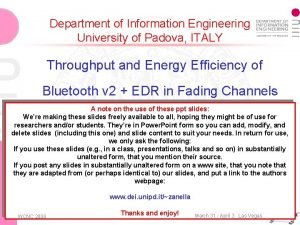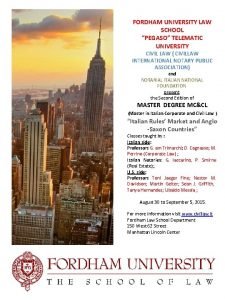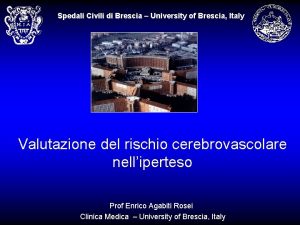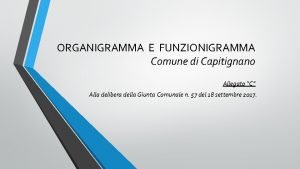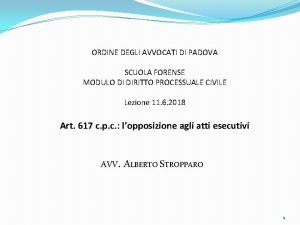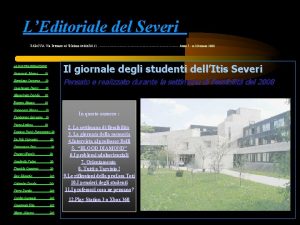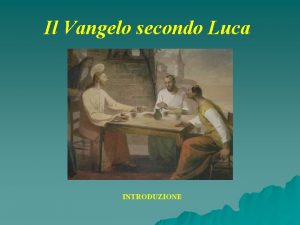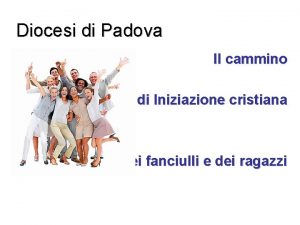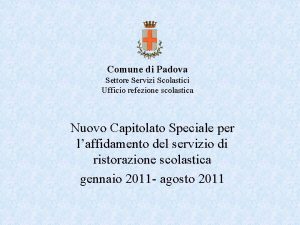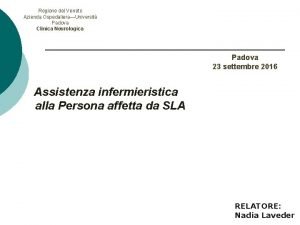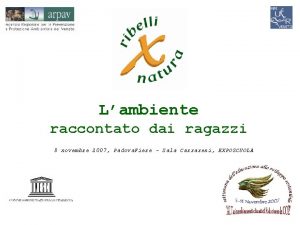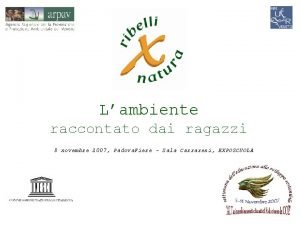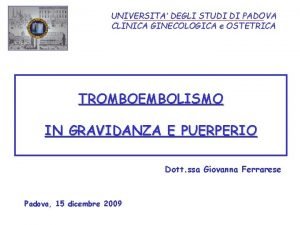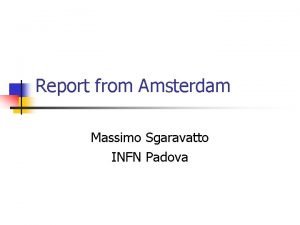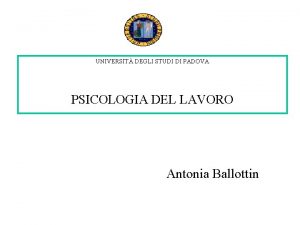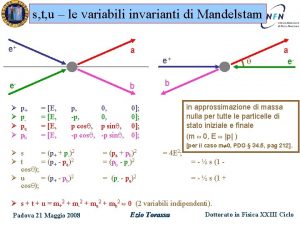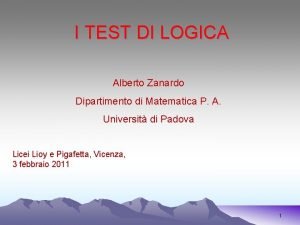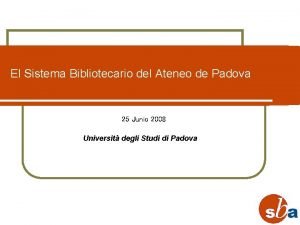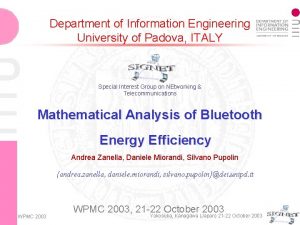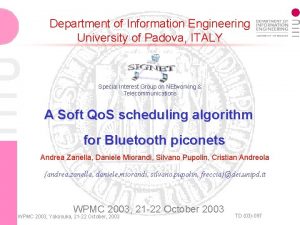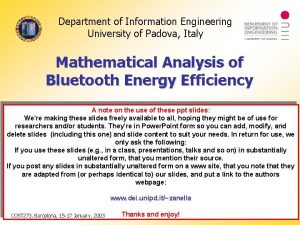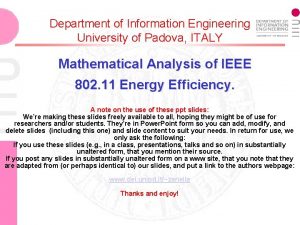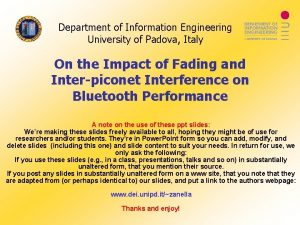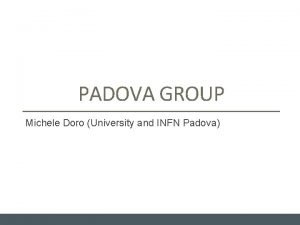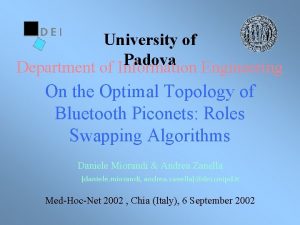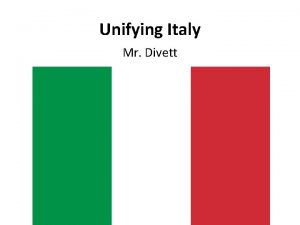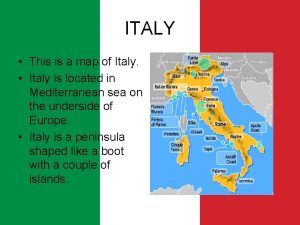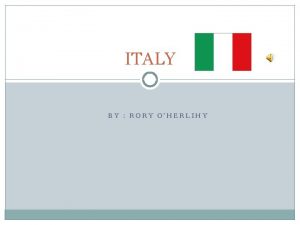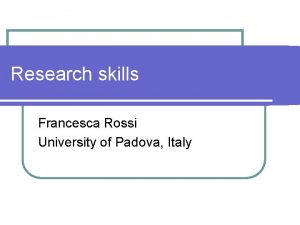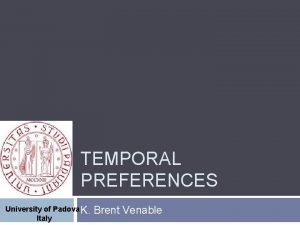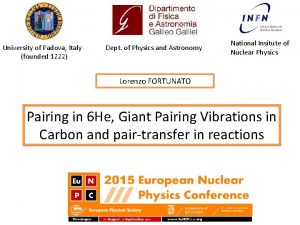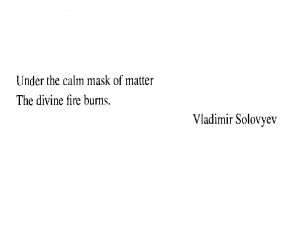Department of Information Engineering University of Padova ITALY



























- Slides: 27

Department of Information Engineering University of Padova, ITALY Throughput and Energy Efficiency of Bluetooth v 2 + EDR in Fading Channels A note on the use of these ppt slides: We’re making these slides freely available to all, hoping they might be of use for researchers and/or students. They’re in Power. Point form so you can add, modify, and delete slides (including this one) and slide content to suit your needs. In return for use, we only ask the following: If you use these slides (e. g. , in a class, presentations, talks and so on) in substantially unaltered form, that you mention their source. If you post any slides in substantially unaltered form on a www site, that you note that they are adapted from (or perhaps identical to) our slides, and put a link to the authors webpage: www. dei. unipd. it/~zanella WCNC 2008 Thanks and enjoy! March 31 - April 3 Las Vegas

Department of Information Engineering University of Padova, ITALY Special Interest Group on NEtworking & Telecommunications Throughput and Energy Efficiency of Bluetooth v 2 + EDR in Fading Channels Andrea Zanella, Michele Zorzi {andrea. zanella, michele. zorzi}@dei. unipd. it Speaker: Marco Miozzo WCNC 2008 March 31 - April 3 Las Vegas

Motivations q Bluetooth was designed to be integrated in portable battery driven electronic devices Energy Saving is a key issue! Ø Ø Ø q Units periodically scan radio channel for valid packets Scanning takes just the time for a valid packet to be recognized Units that are not addressed by any valid packet are active for less than 10% of the time WPAN market is expanding and it aims at becoming the standard the facto for short range communications High Throughput is very welcome! Ø WCNC 2008 Bluetooth v 2. 0 + EDR (Enhanced Data Rate) promise bit rates up to 3 Mbps and faster node connections March 31 - April 3 Las Vegas

Aims of the work q Questions: Ø Are the Bluetooth promises maintained? Ø What’s the energy efficiency & throughput achieved by EDR frame formats in realistic channels? Ø q Which units shall be the Master in point-to-point connections? Answer Ø Well, in most cases, we cannot provide univocal answers… …but we can offer a mathematical model to decide case by case! WCNC 2008 March 31 - April 3 Las Vegas

Basic ingredients q q Define realistic radio channel model Ø Flat Rice-modelled fading channel Ø BER curves for different modulations taken from the literature Capture system dynamic by means of a Finite State Markov Chain (FSMC) Ø q Define appropriate reward functions Ø q State transitions driven by packet reception events Data, Energy, Time Apply renewal reward theorem to get system performance Ø Throughput, energy efficiency, energy balancing, … WCNC 2008 March 31 - April 3 Las Vegas

What standard says… Bluetooth reception mechanism WCNC 2008 March 31 - April 3 Las Vegas

Physical layer q Basic Rate: 1 Mbps Ø q EDR 2: 2 Mbps Ø q GFSK [13] /4 -DQPSK [14] EDR 3 Ø 8 DPSK [15] [13] J. S. Roh, “Performance analysis and evaluation of Bluetooth networks in wireless channel environment, ” ICSNC’ 06 [14] L. E. Millerand. J. S. Lee, “BER Expressions for Differentially Detected π/4 DQPSK Modulation, ” IEEE TRANSACTIONS ON COMMUNICATIONS, vol. 46, no. 1, pp. 71– 81, January 1998. [15] N. Benvenuto and C. Giovanni, Algorithms for Communications Systems and their Applications. Wiley, 2002. March 31 - April 3 Las Vegas WCNC 2008

Baseband frame formats GFSK BR AC HEAD PAYL 0. 22 ms Tslot=0. 625 ms TDxn=n. Tslot DPSK GFSK EDR AC HEAD GUARD SYNC PAYL EDR Trailer 0. 22 ms Tslot=0. 625 ms Tj. Dxn= n. Tslot WCNC 2008 March 31 - April 3 Las Vegas

Retransmissions A B B B NAK MASTER ACK G SLAVE A q Automatic F X H H B X DPCK Retransmission Query (ARQ): Ø Each data packet is transmitted and retransmitted until positive acknowledge is returned by the destination Ø Negative acknowledgement is implicitly assumed! ü Errors on return packet determine transmission of duplicate packets (DUPCK) ü Slave filters out DUPCKs by checking their sequence number Ø Slave does never transmit DUPCKs! ü Slave can transmit when it receives a Master packet ü Master packet piggy-backs the ACK/NACK for previous Slave transmission ü Slave retransmits only when needed! WCNC 2008 March 31 - April 3 Las Vegas

Mathematical Analysis System Model WCNC 2008 March 31 - April 3 Las Vegas

Mathematical Model q Normal State (N) Ø q Duplicate State (D) Ø q q Master transmits packets that have never been correctly received by the slave Master transmits duplicate packets (DUPCKs) The steady-state probabilities are, then, State transition probabilities depend on the reception events… WCNC 2008 March 31 - April 3 Las Vegas

Reception events Reception Event Index Slaves tx q Reception events Ø Master tx Ds = Data successful ü Ø Df = Data failure ü Ø AC error MC state transitions Ø N = enter Normal State ü Ø Ø Master tx non-duplicate packets D = enter Duplicate State ü Master tx DUPCKs X = loop step ü WCNC 2008 AC ok, HEAD error Af = AC failure ü q AC ok, HEAD ok, CRC error Hf = HEAD failure ü Ø AC ok, HEAD ok, CRC ok Return in the same state March 31 - April 3 Las Vegas

Reward Functions q q For each state j we define the following reward functions Ø Tj= Average amount of time spent in state j Ø Dj(x)= Average amount of data delivered by unit x {M, S} Ø Wj(x)= Average amount of energy consumed by unit x {M, S} Ø The average amount of reward earned in state j is given by Performance indexes Ø Energy Efficiency: Ø Goodput: G WCNC 2008 March 31 - April 3 Las Vegas

Time reward ( T ) Master Frame Slave Frame Empty slot n+m n+1 WCNC 2008 March 31 - April 3 Las Vegas

Data reward ( D ) Master’s Data Slave’s Data Dxn Dym Dxn --- No Useful Data Dym ----- WCNC 2008 ----- March 31 - April 3 Las Vegas

Master energy reward ( W(M)) Tx power WCNC 2008 Rx Power Sx power March 31 - April 3 Las Vegas

Slave energy reward ( W ) q Slave’ energy reward resembles mater’ one except that, in D state, Slave does not listen for the PAYL field of recognized downlink packet since it has been already correctly received! WCNC 2008 March 31 - April 3 Las Vegas

Performance Analysis Results WCNC 2008 March 31 - April 3 Las Vegas

AWGN WCNC 2008 March 31 - April 3 Las Vegas

Rayleigh WCNC 2008 March 31 - April 3 Las Vegas

Conclusions q Main Contribution Ø q Results Ø Ø Ø q mathematical framework for performance evaluation of Bluetooth EDR links 3 DHn yield better performance for SNR>20 d. B 2 DHn perform better in the low SNR region 1 DHn always show poor performance Results refer to a specific case study, but the analytical model is general WCNC 2008 March 31 - April 3 Las Vegas

Department of Information Engineering University of Padova, ITALY Mathematical Analysis of Bluetooth Energy Efficiency Andrea Zanella, Daniele Miorandi, Silvano Pupolin Questions? WPMC 2003, 21 -22 October 2003 WCNC 2008 March 31 - April 3 Las Vegas

Extra Slides… Spare slides… WCNC 2008 March 31 - April 3 Las Vegas

Conditioned probabilities Receiver. Correlator Margin (S) AC 72 bits HEAD 54 bits 2 -time bit rep. (1/3 FEC) DHn: Unprotected DMn: (15, 10) Hamming FEC PAYLOAD CRC h=220 2745 bits 0: BER WCNC 2008 March 31 - April 3 Las Vegas

Hypothesis q Single slave piconet q Saturated links Ø q Unlimited retransmission attempts Ø q Packets are transmitted over and over again until positive acknowledgement Static Segmentation & Reassembly policy Ø q Master and slave have always packets waiting for transmission Unique packet type per connection Sensing capability Ø Nodes can to sense the channel to identify the end of ongoing transmissions Ø Nodes always wait for idle channel before attempting new transmissions WCNC 2008 March 31 - April 3 Las Vegas

Packet error probabilities q Let us define the following basic packet reception events Ø Afr: AC does not check ü Ø Hf: AC does check & HEAD does not ü Ø Packet is recognized but PAYL contains unrecoverable errors Ds: AC & HEAD & PAYL do check ü q Packet is not recognized Df: AC & HEAD do check, PAYL does not ü Ø Packet is not recognized Packet is successfully received Packets experiment independent error events because of the frequency hopping mechanism WCNC 2008 March 31 - April 3 Las Vegas

Swapping Master and Slave* *Results not reported in the WCNC paper WCNC 2008 March 31 - April 3 Las Vegas
 Department of information engineering university of padova
Department of information engineering university of padova Information engineering padova
Information engineering padova University of padova psychology
University of padova psychology Information engineering padova
Information engineering padova University of sargodha engineering department
University of sargodha engineering department University of salerno italy
University of salerno italy Pegaso telematic university
Pegaso telematic university Brescia university italy
Brescia university italy Quinto istituto comprensivo padova
Quinto istituto comprensivo padova Organigramma comune di padova
Organigramma comune di padova Scuola forense padova
Scuola forense padova Via pettinati 46 padova
Via pettinati 46 padova Introduzione al vangelo di luca
Introduzione al vangelo di luca Istituto comprensivo forte dei marmi
Istituto comprensivo forte dei marmi Iniziazione cristiana padova
Iniziazione cristiana padova Servizi scolastici padova
Servizi scolastici padova Clinica neurologica padova
Clinica neurologica padova Dai ragazzi padova
Dai ragazzi padova Dai ragazzi padova
Dai ragazzi padova Embricazione coumadin
Embricazione coumadin Moodle psico unipd
Moodle psico unipd Infn padova
Infn padova Amici dei popoli padova
Amici dei popoli padova Psicologia del lavoro padova
Psicologia del lavoro padova Variabili di mandelstam
Variabili di mandelstam Zanardo pediatra padova
Zanardo pediatra padova Sistema bibliotecario ateneo padova
Sistema bibliotecario ateneo padova Burchiello padova
Burchiello padova



